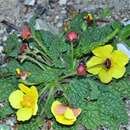en
names in breadcrumbs


Verbascum is a genus of over 450 species of flowering plants, common name mullein (/ˈmʌlɪn/[3]), in the figwort family Scrophulariaceae. They are native to Europe and Asia, with the highest species diversity in the Mediterranean.[4][5]
Mullein or "mullein leaf" often refers to the leaves of Verbascum thapsus, the great or common mullein, which is frequently used in herbal medicine.
Verbascum are biennial or perennial plants, rarely annuals or subshrubs, growing to 0.5 to 3.0 m (1.6 to 9.8 ft) tall. The plants first form a dense rosette of leaves at ground level, subsequently sending up a tall flowering stem. Biennial plants form the rosette the first year and the stem the following season. The leaves are spirally arranged, often densely hairy, though glabrous (hairless) in some species. The flowers have five symmetrical petals; petal colours in different species include yellow (most common), orange, red-brown, purple, blue, or white. The fruit is a capsule containing numerous minute seeds.
In gardening and landscaping, the mulleins are valued for their tall narrow stature and for flowering over a long period of time, even in dry soils.
These cultivars have received the Royal Horticultural Society's Award of Garden Merit:
Plants of the genus have a long history of use as herbal remedies.[10] Although this plant is a recent arrival to North America, Native Americans used the ground seeds of V. thaspus as a paralytic fish poison due to their high levels of rotenone. Verbascum flowers have been used in traditional Austrian medicine internally (as tea) or externally (as ointment, tea, baths, or compresses) for treatment of disorders of the respiratory tract, skin, veins, gastrointestinal tract, and the locomotor system.[11]
Verbascum is a genus of over 450 species of flowering plants, common name mullein (/ˈmʌlɪn/), in the figwort family Scrophulariaceae. They are native to Europe and Asia, with the highest species diversity in the Mediterranean.
Mullein or "mullein leaf" often refers to the leaves of Verbascum thapsus, the great or common mullein, which is frequently used in herbal medicine.